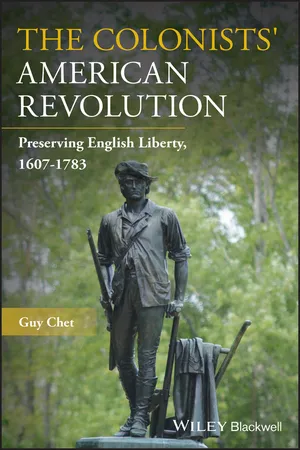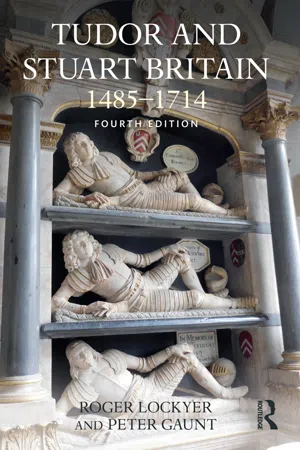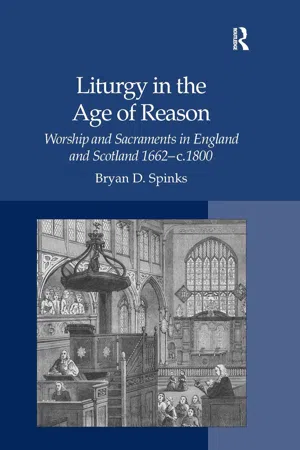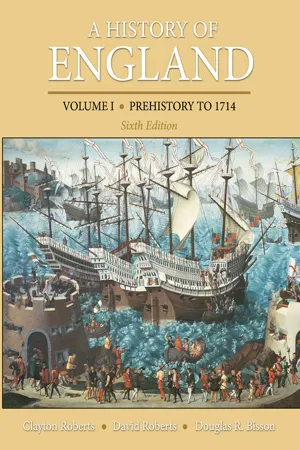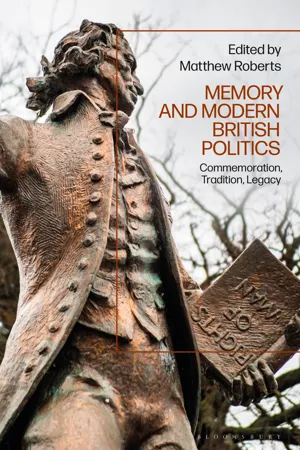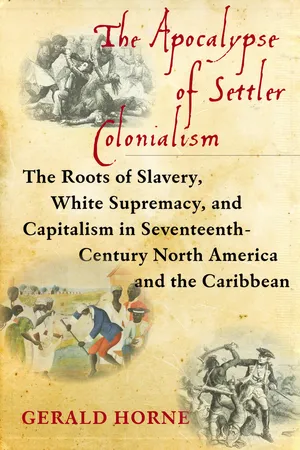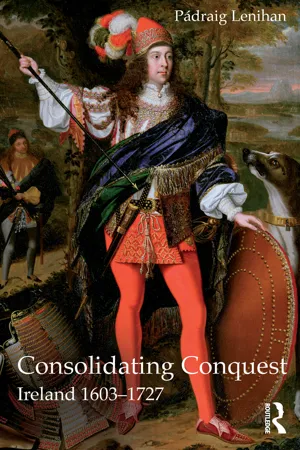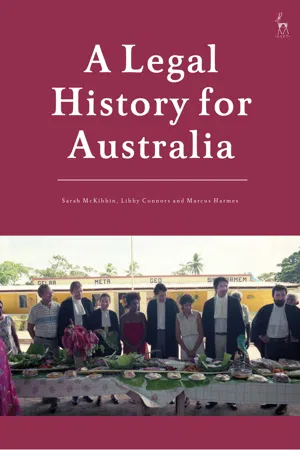History
Glorious Revolution
The Glorious Revolution refers to the peaceful overthrow of King James II of England in 1688 and the ascension of William III and Mary II to the throne. This event marked a significant shift in power from the monarchy to Parliament and established the supremacy of the constitutional monarchy in England. The Glorious Revolution also led to the passage of the Bill of Rights, which limited the powers of the monarchy and affirmed the rights of Parliament.
Written by Perlego with AI-assistance
Related key terms
Related key terms
1 of 4
Related key terms
1 of 3
10 Key excerpts on "Glorious Revolution"
- eBook - ePub
The Colonists' American Revolution
Preserving English Liberty, 1607-1783
- Guy Chet(Author)
- 2019(Publication Date)
- Wiley-Blackwell(Publisher)
4 The Glorious Revolutions in England and America, 1688–1689The Glorious Revolution of 1688 was a seminal event in the political and constitutional history of both England and its colonies, highlighting the longstanding (precolonial) English attachment to liberty and self‐government. What produced this dedication to self‐government in England, as well as in its New World settlements, was the history and culture of England, not uniquely colonial practices (such as slavery) on the peripheries of English civilization.The Glorious Revolution enshrined the supreme political authority of constituents, as represented in their legislatures, and reaffirmed traditional jurisdictional boundaries between the central government and local communities. Its practical effect was to insulate local ruling bodies – in the empire, within England, and within colonies – from central governments. In America, it enshrined “salutary neglect” as the governing principle of imperial administration. It thus set the stage for later constitutional conflicts between colonial assemblies and Parliament over the imperial constitution and English law, following Britain's efforts to centralize imperial governance in the 1760s and 1770s.The Military Origins of the Glorious Revolution in America
The Glorious Revolution in America followed immediately on the heels of, and mirrored, the Glorious Revolution in England. However, it was not merely a ripple effect of the coup that took place in the mother country. Rather, it sprang from causes – some imperial, some regional, some internal within several colonies – which can be traced to American military and diplomatic affairs in the preceding decade. - eBook - ePub
Tudor and Stuart Britain
1485-1714
- Roger Lockyer, Peter Gaunt(Authors)
- 2018(Publication Date)
- Routledge(Publisher)
Chapter 19 James II, the Glorious Revolution and the reign of William III The reigns of James II and William III in perspective With the benefit of hindsight, the history of the 15 years or so following the death of Charles II in 1685 appears not only very complex, with plenty of rapid, dramatic and in many ways unexpected developments, but also to have produced profound and lasting changes in Church and state. After an initially smooth succession, James II’s pro-Catholic policies and his other initiatives generated increasing unease, instability and potential opposition, such that his reign lasted little more than three and a half years. In autumn 1688 he was challenged by the intervention and the largely unopposed invasion of the man who was both his nephew and his son-in-law, William of Orange. James’s nerve broke, he fled abroad and was deemed to have abdicated and he was replaced on the throne by the joint monarchy of William III and his wife, James’s elder daughter, Mary II. A key consequence of this, probably envisaged and sought from the outset – perhaps the only outcome that many Englishmen had initially been seeking – was the abandonment and reversal of most of James’s controversial policies. These developments of autumn and early winter 1688, achieved with limited violence and largely bloodlessly in most of England and Wales – though they created much bigger waves in Ireland and Scotland (see Chapter 21) – came to be known as the Glorious Revolution. This led on not just to a change in monarch and the abandonment of James’s policies but, it is usually argued, to far wider and more profound alterations in government and administration, in politics and religion, in the financial organization and foreign policy of the state. Some of these developments were expected at the time of the Glorious Revolution but others were unexpected, unintended or indirect consequences - eBook - ePub
Liturgy in the Age of Reason
Worship and Sacraments in England and Scotland 1662–c.1800
- Bryan D. Spinks(Author)
- 2016(Publication Date)
- Routledge(Publisher)
CHAPTER 3The Glorious Revolution and Liturgical Plurality
The accession of the Roman Catholic James II on 6 February 1685 directed the minds of all Protestants toward the threat of popery. James’ attempt to appoint Roman Catholics to key posts, and the granting of the Declaration of Indulgence of April 1687 sharpened their fears. Although Independents and Baptists, who had never contemplated comprehension within the Church of England, accepted the Indulgence, some Presbyterians made overtures to the Church of England in order to face the common threat.1 The Declaration was reissued in April 1688 and ordered to be read in Churches in London and Westminster on 20 and 27 May, and throughout the country in June. Archbishop Sancroft and six other bishops signed a petition to James, refusing to read the Declaration. They were imprisoned in the Tower of London and tried for publishing seditious libel, but were acquitted on 30 June 1688. The same day the Admiral of the Fleet, Arthur Herbert, carried a letter to Holland which would lead to the accession of William of Orange and the ‘Glorious’ Revolution.Earlier Whig interpretations of the subsequent events of 1688/89, portraying William as the bringer of political liberty, constitutional stability, economic progress and religious freedom, and deeming the revolution ‘Glorious’, were extravagant rhetoric. Craig Rose’s unadorned account is more accurate:On 5 November 1688 a Dutch army invaded England. Six weeks later, it occupied London, expelling the Catholic King, James II, from his capital. By mid-February its commander, Prince William of Orange, had been proclaimed King of England, the last monarch to attain the crown by force of arms.2The invasion had been carefully planned, though the intention of actually becoming King of England only unfolded in the days after the landing. Whatever the interpretation of the Dutch invasion, the subsequent flight of James II of England and VII of Scotland, and the accession of William and Mary to the throne in both Kingdoms were defining moments in the life and worship of the Churches of England and Scotland. Two Scottish clergyman who accompanied William, Gilbert Burnet and William Carstares, would play significant roles in the future of both Churches. Burnet (1643–1715) had been educated at Marischal College, Aberdeen, and was minister of Saltoun from 1664 to 1669 when he became Professor of Divinity at Glasgow University. In 1674 he settled in England, but fled abroad at the failure of the Exclusion Controversy which had sought to bar the Catholic James from inheriting the throne. Content with Episcopacy, Burnet was made Bishop of Salisbury by William in 1689. William Carstares (1649–1715) was the son of a convinced Presbyterian, and was educated at Edinburgh and Utrecht. He had suffered imprisonment and torture under Charles II, and after release returned to Holland where he was a minister in Leiden and a chaplain to William of Orange. King William’s trusted confidant on Scottish affairs, Carstares would later serve as Moderator of the General Assembly of the Church of Scotland. However, in November 1688 both churchmen returned to two Churches both governed by Episcopacy, each challenged by nonconformity, but possessing different worship traditions and sacramental theologies. - eBook - ePub
A History of England, Volume 1
Prehistory to 1714
- Clayton Roberts, F David Roberts, Douglas Bisson(Authors)
- 2016(Publication Date)
- Routledge(Publisher)
The Convention Parliament met on January 22, 1689, and during the next year drew up a settlement in Church and State that Edmund Burke a century later regarded as one of the most perfect works of man. The first issue that faced the convention was the succession to the Crown. The Tories clung to the principle of hereditary monarchy like limpets to a rock, but they were divided among those who were for restoring James on conditions, those who were for a regency, and those who were for granting the Crown to Mary alone. The Whigs subjected the various Tory solutions to a barrage of criticism, and William let it be known that he would return to the Netherlands if not given a share of the Crown. The Lords held out the longest, but finally agreed with the Commons that King James II had "endeavored to subvert the constitution of his kingdom by breaking the original contract between king and people," had "violated the fundamental laws," had "abdicated the government" by his flight, and that "the throne is thereby vacant." The two Houses thereupon voted to grant the Crown to William and Mary jointly, with the administration in William's hands.But they made the grant conditional. When on February 13, in the exquisitely proportioned splendor of the Banqueting Hall, they offered the Crown to the two monarchs, they first secured their assent to a Declaration of Rights. The Declaration asserted that it was illegal to suspend or dispense with the laws, to collect taxes by prerogative, to maintain a standing army without the consent of Parliament, to interfere in parliamentary elections, to tamper with juries, or to impose excessive fines or bail. In December Parliament turned the Declaration of Rights into the Bill of Rights, adding two new provisions. The first declared that no Catholic could succeed to the Crown; the second placed the succession in the children of William and Mary, then in those of Anne (Mary's younger sister), and finally in those of William should he marry again.The Declaration and the Bill of Rights contained almost no new law. In this sense the Glorious Revolution was really a Glorious Restoration, the restoration of a constitution James had invaded. England had new monarchs, but not a new monarchy. This was true if one ignores the financial settlement that accompanied the political settlement, but one should not. Parliament in 1690 repudiated once and for all the ancient principle that the king should "live of his own." It voted William and Mary the customs revenues for only four years, not for life, and it voted a permanent revenue (including the customs) which fell at least £200,000 short of peacetime expenditures. All this it did knowingly, not from ignorance or confusion. It deliberately voted an inadequate revenue in order to secure frequent Parliaments. The Bill of Rights protected the liberty of the subject; the financial settlement guaranteed the power of Parliament. - eBook - ePub
Memory and Modern British Politics
Commemoration, Tradition, Legacy
- Matthew Roberts, Matthew Roberts(Authors)
- 2023(Publication Date)
- Bloomsbury Academic(Publisher)
By 1848, they were virtually absent: a full-text search in a digitized copy of the Northern Star yields very few results about the Glorious Revolution, while the paper regularly published material about the French Revolution. 50 The phrase ‘Glorious Revolution’ became loosened from 1688 and was applied to recent events on the continent. When the Fraternal Democrats commemorated the French revolution of February 1848, they talked of ‘Glorious Revolution’ but they never mentioned the English precedent of 1688. 51 However, though some radicals found it was a palace coup, an inglorious business or at best a missed opportunity for real change, others had their uses of the Glorious Revolution. It could justify a general right to revolution. As Edward Thompson noted, in 1817, ‘Henry White, the editor of the moderate Independent Whig, was only one among many Radical journalists who reminded readers of the precedent of the Glorious Revolution of 1688’: ‘it is to a Revolution, White wrote, they will be ultimately compelled to resort, if all other legal means be denied of obtaining a Redress of Grievances’. 52 But in general, the Bill of Rights was widely known to enshrine basic rights that the government must respect, especially the right to bear arms and the right to petition the king. The London Corresponding Society (LCS), for all its pacific stance, justified the possession of arms by the Bill of Rights. 53 In 1817, Jeremiah Brandreth also evoked the right to bear arms during his trial following the Pentrich rising. 54 The Hanoverian dynasty owed its position to the Revolution, which implied that loyalty to the reigning house and monarchs entailed not just the right but the duty of resistance to tyranny - eBook - ePub
The Apocalypse of Settler Colonialism
The Roots of Slavery, White Supremacy, and Capitalism in 17th Century North America and the Caribbean
- Gerald Horne(Author)
- 2018(Publication Date)
- Monthly Review Press(Publisher)
CHAPTER 8The “Glorious Revolution” of 1688: Not So Glorious for Africans and the IndigenousP ut simply, the “Glorious Revolution” of 1688 involved the deposing of King James II and the accession of William III and Mary II to the English throne. For purposes here, the import was a step toward Cromwell and away from the apparent repercussions of the royal restoration after he expired. More to the point, it involved a weakening of the Royal African Company and the monarch and the rise of merchants to the top ranks of this repugnant business, under the guise of strengthening the demos. Given the grimy origins of republicanism and “democracy” in the Anglo-American sphere, is it any wonder that even in today’s United States, it remains difficult to extend the full bounty of rights to the descendants of the formerly enslaved or the indigenous?BY 1680 BARBADOS WAS the richest colony in North America, sufficiently powerful to generate a “colony” of its own: South Carolina.1 The future Palmetto State quickly developed a model of development comparable to that of this Caribbean island, including an often rebellious African majority. This restive majority’s propensity for allying with indigenes and foreign invaders alike was to jeopardize all of London’s holdings in North America.Once the African Slave Trade accelerated after deregulation in 1688, however, Barbados simply could not absorb the massive influx of enchained Africans crossing the Atlantic, whereas the mainland could. Thus an enriching transformation of North America accelerated wildly, with Africa transformed also in an accelerative fashion, albeit in the opposing direction: impoverishment. This set the stage for a lurch toward secession in 1776. In that context, the recent thesis that 1776 represented a revolt against Parliament and not the monarch makes sense.2 - eBook - ePub
Consolidating Conquest
Ireland 1603-1727
- Padraig Lenihan(Author)
- 2014(Publication Date)
- Routledge(Publisher)
CHAPTER 9 James II 1685-91The ‘Glorious Revolution’
James II believed that God had brought him to power in the face of so many obstacles for the great purpose of converting England. Time was short. He was in late middle age and had no legitimate Catholic heirs and so he set a breakneck pace of religious change. His consistent objective was to 'establish' Catholicism: that is, to secure legal toleration that would survive his death and the Protestant successors, namely his daughter Mary and her husband (and James's nephew) the Dutch stadholder William of Orange.1 His means of achieving that objective changed over time.James’s natural supporters, the Tory-Anglicans, were motivated less by personal loyalty to the monarch than by acceptance of a symbiosis of crown and church. James alienated them by relentlessly promoting Catholicism, especially at a time when Louis XIV’s persecution of the Huguenots increased popular fears of resurgent popery and persecution. James’s Declaration of Indulgence of April 1687 was a desperate attempt to forge an alternative alliance with dissenters and Whigs: dismay that indulgence would extend to papists outweighed any dissenter gratitude for their own toleration.James could have limped along, unpopular but unassailable, to his death. Even the birth of a Catholic heir (the future James III or ‘Old Pretender’ was born in June 1688) and the disagreeable prospect of a Catholic dynasty did not make his collapse inevitable. James’s former Tory supporters feared anarchy and abhorred the idea of active resistance. Whig accusations that James was bent on creating a despotic monarchy were implausible and reflect an instinctive linking of popery and absolutism, but his regime was absolutist to the extent that its bedrock was an army of 20,000 regular soldiers.2 No purely domestic revolt could succeed against them.To understand why James II’s regime collapsed in November 1688, then, it is necessary to privilege the wider European context. The War of the Grand Alliance (1689–97) subsumed two conflicts. One was yet another round of the century-old Bourbon–Habsburg contest, the other a Franco–Dutch war sparked by Louis XIV’s expansionism in the Rhineland and his resumption of economic warfare against the Dutch in the autumn of 1687. James wanted to stand aside from this looming conflict, but English neutrality raised the spectre of a renewed Anglo–French alliance.3 Consequently the States-General embarked on a ‘risky and momentous enterprise’ to force a man they saw as Louis XIV’s English stooge to back the Grand Alliance.4 - eBook - ePub
- Sarah McKibbin, Libby Connors, Marcus Harmes(Authors)
- 2021(Publication Date)
- Hart Publishing(Publisher)
The monarchy was restored in 1660. Charles I’s son, Charles II, took the throne. The new Royalist or Cavalier Parliament had three pressing items of business. In the first place, both Parliament and a monarch were required for the English Constitution to function. Second, religious conformity was necessary to suppress Puritans (as punishment) and Catholics (for past transgressions), and to establish a Church of England led by bishops as the national religion. Third, violence was a demonstrably ineffective weapon, as proven by the English Civil War, with the execution of Charles I, and throughout the Interregnum.Charles II’s 12 years of exile had produced a king who was pragmatic and shrewd about matters of state. The Cavalier Parliament restored Charles II to executive power. It granted him an extremely generous financial settlement to cover government costs. Though denied to his father, Parliament granted Charles II customs for life. Behind closed doors, Charles II secretly negotiated with Louis XIV of France to receive a handsome subsidy on the condition that he would declare himself Catholic at a convenient time.The Glorious RevolutionIn 1685, Charles II (1660–85) died. His brother, the Catholic James, Duke of York, came to the thrones of England and Scotland as James II and VII (1685–88). James II’s reign was short. It ended with the ‘Glorious Revolution’, James II fleeing England, and new Protestant monarchs (William III and Mary II, James’s daughter) on the throne.Before the RevolutionTo set the Glorious Revolution in context, four events took place in the last decade of Charles II’s reign: the Popish Plot, the Rye House Plot, the Exclusion Crisis and the Monmouth Rebellion. A second reason for considering these events is to recognise the old religious prejudices exploited to promote fear and distrust of an absolutist Catholic monarchy.The Popish Plot started in 1678. Titus Oates, a defrocked priest of highly questionable character, claimed that there was a Catholic plot to assassinate Charles II, install James as King, burn down London, and raise a Scottish and Irish rebellion against the Protestants to restore Roman Catholicism as England’s official religion. The historian Edward Carpenter memorably recounts Oates’ career as ‘in turn Anglican vicar, naval chaplain, Roman Catholic student, embryonic Jesuit, Government pensioner, and finally zealous Baptist’.113 If that sounds like a tall tale, it was. In reality, there was no plot and Oates was later tried for perjury.114 The Government was not initially convinced either, but two coincidences led to Oates’ claims gaining greater momentum. First, the former secretary of James, the King’s brother, had been secretly corresponding with the French court to reinstate Catholicism in England. The second coincidence was the still unsolved murder of Sir Edmund Berry Godfrey. Godfrey was the Justice of the Peace who had first interrogated Oates about his fanciful claims. The Popish Plot capitalised on anti-Catholic fear and distrust in England, and it worked. Distrust gripped England. Prominent Catholics at the royal court, including the Queen’s servants, left the kingdom.115 - eBook - ePub
Revolutions and the Revolutionary Tradition
In the West 1560-1991
- David Parker, David Parker(Authors)
- 2002(Publication Date)
- Routledge(Publisher)
4 1688: A political revolutionW. A. SpeckIntroduction
On 11 December 1688 James II fled from his capital city and made his way down the Thames hoping to escape to France. His departure produced the first breakdown of government in the Glorious Revolution. For a time a group of peers agreed to ‘take upon them the Government for the preservation of the Kingdom and this great City’. As one of them noted, ‘we had otherwise been a state of banditi, and London had certainly been the spoil of the rabble’. This alternative administration did not last long, for the King returned to the capital on 16 December. He had been intercepted by fishermen at Faversham, from whom he had been rescued by a party of guards sent to bring him back to London. James tried to resume the reins of power and even held a meeting of the privy council. But when William of Orange entered the capital on 18 December he asked the King to remove himself from the seat of government and James agreed, retiring to Rochester. Once more there was a vacuum of power, which the peers, meeting in the House of Lords, again attempted to fill. When James fled to France on 23 December, however, this time successfully, they met on Christmas Eve and asked William to call a free Parliament to meet on 22 January, and meanwhile to take upon himself ‘the administration of public affairs, both civil and military, and the disposal of the public revenue’. He delayed acceptance until former Members of Parliament of King Charles II’s time also asked him to govern the country on 26 December. William then carried out the task not just until the Convention assembled, for it too asked him to be chief executive until the constitutional position had been resolved. He therefore governed the country by virtue of these informal ad hoc arrangements until 13 February, when he and his wife Mary, James’ daughter, accepted the Convention’s offer of the Crown.For seven weeks, therefore, England was without a king or queen. This was a unique era in constitutional history, for the rule was ‘the king is dead, long live the king’. No interregnum was recognised legally even between the execution of Charles I in 1649 and the Restoration of 1660. Charles II dated his reign from the day of his father’s death. The Convention elected in 1689, however, accepted that the throne was vacant between the flight of James II and the acceptance by William and Mary of the Bill of Rights. This was arguably the most telling sign that 1688 was a truly revolutionary year.1 - eBook - ePub
The Stuart Age
England, 1603–1714
- Barry Coward, Peter Gaunt(Authors)
- 2017(Publication Date)
- Routledge(Publisher)
Nor, contrary to legend, was the offer of the throne to William and Mary made conditional on their accepting even the castrated version of the Declaration of Rights. Though the declaration was read to them before they formally accepted the crown, neither William nor Mary gave any indication that they felt bound to adhere to its provisions. 15 There are many possible reasons for the limited nature of the constitutional settlement in 1689. Probably for some MPs William’s known intention not to allow drastic inroads into the royal prerogative was important, and ambitious politicians took the hint. Certainly some Whigs in 1689 seemed less in favour of restricting the power of the crown than might have been expected, given the attitude of Whigs during the Exclusion Crisis, largely because they hoped that it would be Whig ministers who would dominate the new king’s government. For most MPs, however, the most important consideration was the pressing need to fill the throne quickly and not to waste time in drafting and passing complicated constitutional legislation. The Declaration of Rights (enacted as the Bill of Rights in December 1689) was a conservative document. 16 Apart from bringing about a change of monarchs, it brought about no fundamental alterations in the constitution. These were to be brought about by the Glorious Revolution of the 1690s and early 1700s, not the Glorious Revolution of 1688–9. The Church: comprehension or toleration? The Glorious Revolution of 1688–9, like the Restoration, presented another opportunity to widen the membership of the Church of England and extend toleration to those Protestants outside the Church. As in 1660, the hopes of non-Anglicans were raised both by the expectation of some reward for their political role in the events of the immediate past and by the tolerationist views of the new king
Index pages curate the most relevant extracts from our library of academic textbooks. They’ve been created using an in-house natural language model (NLM), each adding context and meaning to key research topics.
Explore more topic indexes
Explore more topic indexes
1 of 6
Explore more topic indexes
1 of 4
